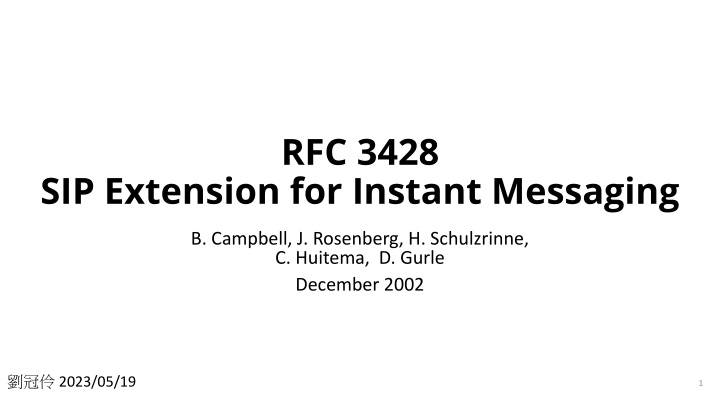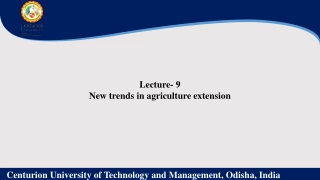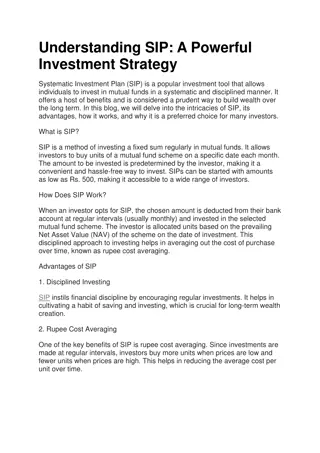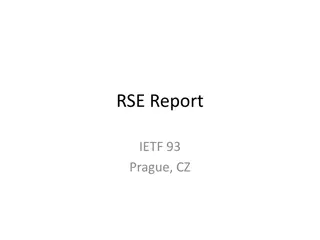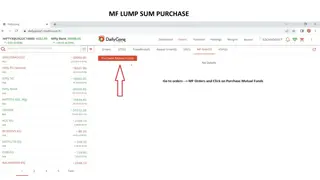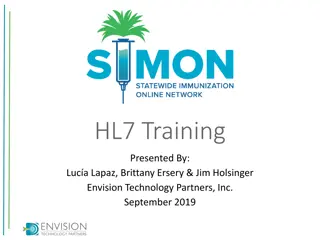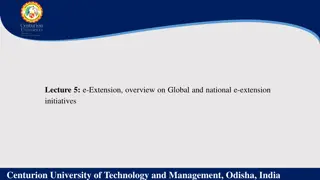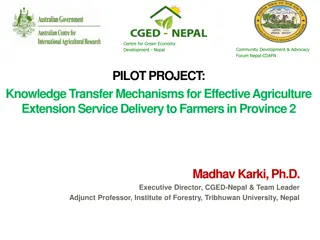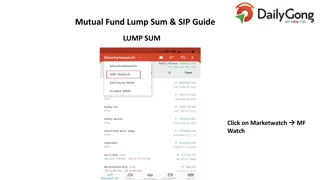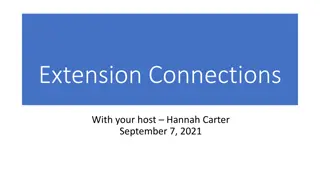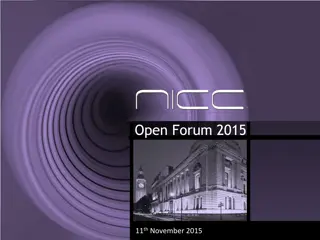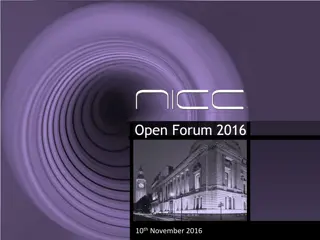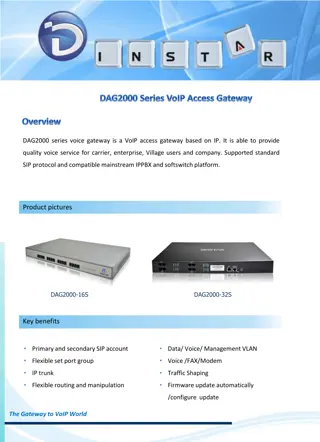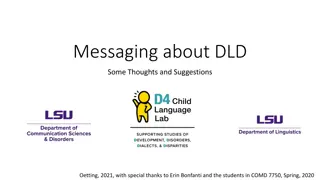RFC 3428 SIP Extension for Instant Messaging
This document introduces the MESSAGE method as an extension to the Session Initiation Protocol (SIP) for facilitating the transfer of instant messages in near real-time. Instant Messaging (IM) allows users to exchange content swiftly, often coupled with presence and buddy lists. The document outlines the key methods of SIP, the nature of IM applications, and considerations for handling message content and media. It also provides insights into the process of sending instant messages via SIP requests.
Download Presentation

Please find below an Image/Link to download the presentation.
The content on the website is provided AS IS for your information and personal use only. It may not be sold, licensed, or shared on other websites without obtaining consent from the author.If you encounter any issues during the download, it is possible that the publisher has removed the file from their server.
You are allowed to download the files provided on this website for personal or commercial use, subject to the condition that they are used lawfully. All files are the property of their respective owners.
The content on the website is provided AS IS for your information and personal use only. It may not be sold, licensed, or shared on other websites without obtaining consent from the author.
E N D
Presentation Transcript
RFC 3428 SIP Extension for Instant Messaging B. Campbell, J. Rosenberg, H. Schulzrinne, C. Huitema, D. Gurle December 2002 2023/05/19 1
RFC 3428 Session Initiation Protocol (SIP) Extension for Instant Messaging Instant Messaging (IM) refers to the delivery of messages between users in near real-time. This document proposes the MESSAGE method, an extension to the Session Initiation Protocol (SIP) that allows the transfer of Instant Messages. The basic 6 methods of SIP are: 1. REGISTER 2. INVITE 3. ACK 4. BYE 5. CANCEL 6. OPTIONS 2
Instant Messaging Instant Messaging (IM) is defined as the exchange of content between a set of participants in near real time. has been used as a service coupled with presence and buddy lists; that is, when a friend comes online, a user can be made aware of this and have the option of sending the friend an instant message. 3
MESSAGE An extension method for SIP MESSAGE requests normally carry the instant message content in the request body MESSAGE requests arguably carry media rather than signaling IM applications are typically high volume. This will likely cause congestion problems if sent over a transport without congestion control. 4
Overview 1. When one user wishes to send an instant message to another, the sender formulates and issues a SIP request using the new MESSAGE method defined by this document. 2. The request may traverse a set of SIP proxies, using a variety of transports, before reaching its destination. 3. Provisional and final responses to the request will be returned to the sender as with any other SIP request. MESSAGE requests do not establish dialogs 5
SIP Call Establishment [1/2] Bob Alice REGISTER 200 OK 1 2 INVITE INVITE 3 180 Ringing 180 Ringing 5 200 OK 6 ACK 7 Conversation BYE 8 9 OK 6
Boss<sip:Manager@pc1.home.com> sip:Server.work.com Daniel<sip:Collins@station1.work.com> a b MESSAGE sip:Collins@work.com SIP/2.0 Via: SIP/2.0/UDP pc1.home.net; branch=z9hG4bK7890 Max-Forwards: 70 From: Boss<sip:Manager@home.net> To: Daniel<sip:Collins@work.com> Call-ID: 123456@pc1.home.net CSeq: 1 MESSAGE Content-Type: text/plain Content-Length: 19 Content-Disposition: render MESSAGE sip:Collins@work.com SIP/2.0 Via: SIP/2.0/UDP server.work.com; branch=z9hG4bKxyz1 Via: SIP/2.0/UDP pc1.home.net; branch=z9hG4bK7890 Max-Forwards: 69 From: Boss<sip:Manager@home.net> To: Daniel<sip:Collins@work.com> Call-ID: 123456@pc1.home.net CSeq: 1 MESSAGE Content-Type: text/plain Content-Length: 19 Content-Disposition: render Hello. How are you? Hello. How are you? c d SIP/2.0 200 OK Via: SIP/2.0/UDP server.work.com; branch=z9hG4bKxyz1 Via: SIP/2.0/UDP pc1.home.net; branch=z9hG4bK7890 From: Boss<sip:Manager@home.net> To: Daniel<sip:Collins@work.com> Call-ID: 123456@pc1.home.net CSeq: 1 MESSAGE Content-Length: 0 SIP/2.0 200 OK Via: SIP/2.0/UDP pc1.home.net; branch=z9hG4bK7890 From: Boss<sip:Manager@home.net> To: Daniel<sip:Collins@work.com> Call-ID: 123456@pc1.home.net CSeq: 1 MESSAGE Content-Length: 0 8
Boss<sip:Manager@pc1.home.com> sip:Server.work.com Daniel<sip:Collins@station1.work.com> e f MESSAGE sip:Manager@home.net SIP/2.0 Via: SIP/2.0/UDP station1.work.com; branch=z9hG4bK123 Max-Forwards: 70 From: Daniel<sip:Collins@work.com> To: Boss<sip:Manager@home.net> Call-ID: 456789@station1.work.com CSeq: 1101 MESSAGE Content-Type: text/plain Content-Length: 22 Content-Disposition: render MESSAGE sip:Manager@home.net SIP/2.0 Via: SIP/2.0/UDP server.work.com; branch=z9hG4bKabcd Via: SIP/2.0/UDP station1.work.com; branch=z9hG4bK123 Max-Forwards: 69 From: Daniel<sip:Collins@work.com> To: Boss<sip:Manager@home.net> Call-ID: 456789@station1.work.com CSeq: 1101 MESSAGE Content-Type: text/plain Content-Length: 22 Content-Disposition: render I m fine. How are you? I m fine. How are you? g h SIP/2.0 200 OK Via: SIP/2.0/UDP server.work.com; branch=z9hG4bKabcd Via: SIP/2.0/UDP station1.work.com; branch=z9hG4bK123 From: Daniel<sip:Collins@work.com> To: Boss<sip:Manager@home.net> Call-ID: 456789@station1.work.com CSeq: 1101 MESSAGE Content-Length: 0 SIP/2.0 200 OK Via: SIP/2.0/UDP station1.work.com; branch=z9hG4bK123 From: Daniel<sip:Collins@work.com> To: Boss<sip:Manager@home.net> Call-ID: 456789@station1.work.com CSeq: 1101 MESSAGE Content-Length: 0 9
Example 10
Example (Cont.) F1 MESSAGE User1 -> Proxy MESSAGE sip:user2@domain.com SIP/2.0 Via: SIP/2.0/TCP user1pc.domain.com;branch=z9hG4bK776sgdkse Max-Forwards: 70 From: sip:user1@domain.com;tag=49583 To: sip:user2@domain.com Call-ID: asd88asd77a@1.2.3.4 MUST NOT insert Contact header fields carry the instant message content in the request body CSeq: 1 MESSAGE Content-Type: text/plain Content-Length: 18 Watson, come here. 11
Example (Cont.) F2 MESSAGE Proxy -> User2 MESSAGE sip:user2@domain.com SIP/2.0 Via: SIP/2.0/TCP proxy.domain.com;branch=z9hG4bK123dsghds Via: SIP/2.0/TCP user1pc.domain.com;branch=z9hG4bK776sgdkse;received=1.2.3.4 Max-Forwards: 69 From: sip:user1@domain.com;tag=49583 To: sip:user2@domain.com Call-ID: asd88asd77a@1.2.3.4 CSeq: 1 MESSAGE Content-Type: text/plain Content-Length: 18 12 Watson, come here.
Example (Cont.) F3 200 OK User2 -> Proxy SIP/2.0 200 OK Via: SIP/2.0/TCP proxy.domain.com;branch=z9hG4bK123dsghds;received=192.0.2.1 Via: SIP/2.0/TCP user1pc.domain.com;;branch=z9hG4bK776sgdkse; received=1.2.3.4 From: sip:user1@domain.com;tag=49583 To: sip:user2@domain.com;tag=ab8asdasd9 Call-ID: asd88asd77a@1.2.3.4 MUST NOT contain a body CSeq: 1 MESSAGE Content-Length: 0 13
Example (Cont.) F4 200 OK Proxy -> User1 SIP/2.0 200 OK Via: SIP/2.0/TCP user1pc.domain.com;branch=z9hG4bK776sgdkse;received=1.2.3.4 From: sip:user1@domain.com;;tag=49583 To: sip:user2@domain.com;tag=ab8asdasd9 Call-ID: asd88asd77a@1.2.3.4 CSeq: 1 MESSAGE Content-Length: 0 14
RFC 3994 Indication of Message Composition for Instant Messaging H. Schulzrinne Columbia University January 2005 15
Motivation By definition, instant messaging (IM) is message based: A user composes a message by, for example, typing, speaking, or recording a video clip. This message is then sent to one or more recipients. Unlike email, instant messaging is often conversational, so the other party is waiting for a response. If no response is forthcoming, a participant in an instant messaging conversation may erroneously assume either that the communication partner has left or that it is her turn to type again, leading to two messages "crossing on the wire". 16
Indication of Message Composition To avoid the aforementioned uncertainty, a number of commercial instant messaging systems feature an "is-typing" indication sent as soon as one party starts typing a message. RFC 3994 defines the isComposing status message. This status message is delivered to the instant message recipient in the same manner as are the messages themselves. The status messages are carried as XML, and labeled as an application/im-iscomposing+xml content type. 17
Figure 1. Sender State Diagram +-------------+ |+-----------+| || || +------>| idle |<--------+ | || || | | |+-----------+| | | +------+------+ | content | | | idle timeout msg. sent | | composing | w/o activity ----------- | | ------------- | ------------------ -- | | "active" msg. | "idle" status msg. | | | | +------V------+ | | | | | | | | | | | | | +------+ active +--------+ | | | |------+ +------^------+ | refresh timeout | | -------------------- | | "active" status msg. +-------------+ Condition Output 18
Figure 2. Receiver State Diagram +-------------+ |+-----------+| || || +------>| idle |<------+ | || || | | |+-----------+| | | +------+------+ | | | | "idle" recd. | |"active" msg.| refresh timeout or content recd. | | | or 120s | | | | +------V------+ | | | | | | | | | | | | | +------+ active +------+ | | | | +-------------+ Default value if the refresh interval is omitted in the previous active status msg. 19
Examples <?xml version="1.0" encoding="UTF-8"?> <isComposing xmlns="urn:ietf:params:xml:ns:im-iscomposing" xmlns:xsi="http://www.w3.org/2001/XMLSchema-instance" xsi:schemaLocation="urn:ietf:params:xml:ns:im-composing iscomposing.xsd"> <state>active</state> <contenttype>text/plain</contenttype> <refresh>90</refresh> </isComposing> <?xml version="1.0" encoding="UTF-8"?> <isComposing xmlns="urn:ietf:params:xml:ns:im-iscomposing" xmlns:xsi="http://www.w3.org/2001/XMLSchema-instance" xsi:schemaLocation="urn:ietf:params:xml:ns:im-composing iscomposing.xsd"> <state>idle</state> <lastactive>2003-01-27T10:43:00Z</lastactive> <contenttype>audio</contenttype> </isComposing> 20
[Lab] Instant Messaging http://course.ipv6.club.tw/VoIP/1113/rfc3428-im.html No class on 7/10 (Mon) Code tracing on 7/12 (Wed) 21
